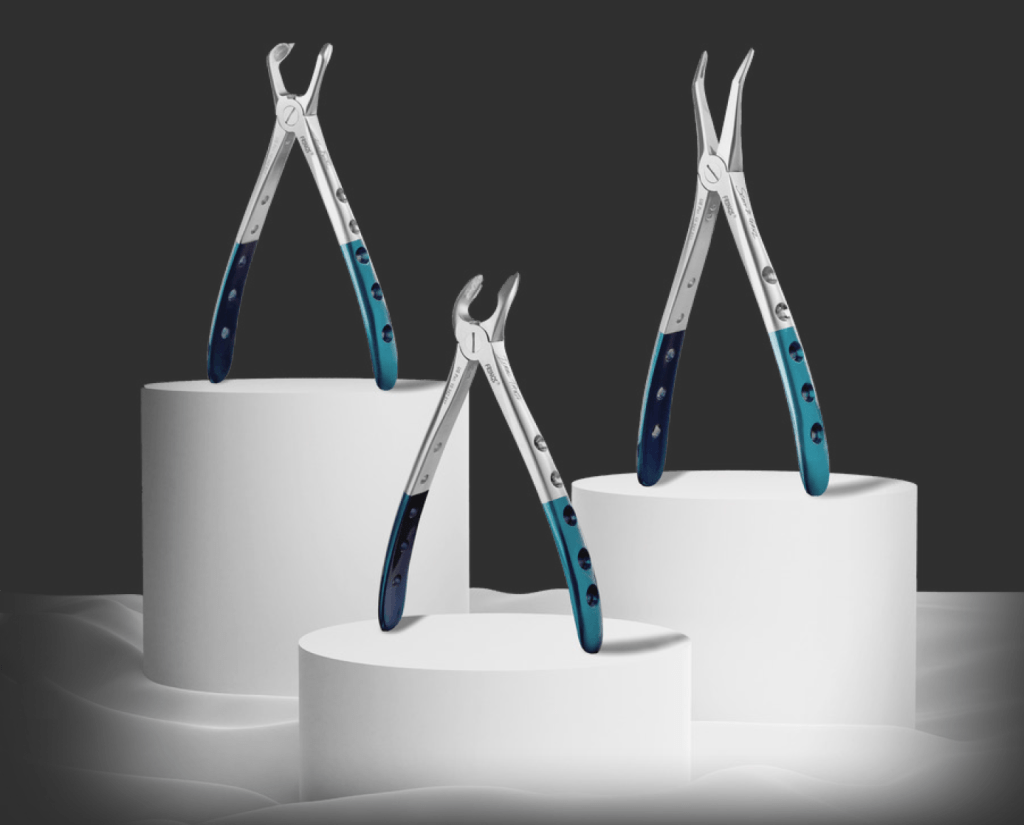
TBS DENTAL
Innovative Instruments for Easy, Atraumatic Extractions
With a spring-driven, auto-retractable design and the use of tapered, beveled, and serrated beaks,
FRINGS provide greater control and less strain during surgical procedures
in 45 years of practice, Dr. Andrew Mogelof has always strived to
treat his patients with the standard of care he would expect as
the patient himself. For surgical procedures like extractions, that
means choosing the instruments and methods he would want his
dentist to use. Thankfully, advances in instrument technology have
made it easier to achieve predictable results while providing a
more comfortable patient experience.
“Over time, surgical instruments have certainly evolved
so we can now take a more conservative approach to
extractions,” he said, describing improvements in the grip,
ergonomics, and overall performance of instruments used
for luxation, elevation, and extraction.
Seeking to modernize surgical instruments and
make dentistry as efficient as possible, TBS Dental has
transformed into a powerhouse of innovation with state-
of-the-art products. In particular, its patented FRINGS, or
forceps with a spring, have set a new standard in exodontia
by bringing simplicity and efficiency to extraction
procedures.

Taking the Crown
With a spring-loaded, auto-retractable design, FRINGS
remove the need to manually open forceps with one’s
fingers, allowing the clinician to easily hold and control
the instrument in a position with less stress on the hand.
This grip frees up the index finger so it can be placed on
the hinge of the forceps to apply apical pressure during
subgingival seating and luxation.

Mogelof, DDS
“I really like the fact that the spring
action allows you to manipulate
and open and close the beak
without feeling that you’re going
to lose control of the forceps.”
“The forceps are very easy to use,” said Dr. Mogelof. “I really like the fact that the spring action allows you to manipulate and
open and close the beak without feeling that you’re going to lose control of the forceps. That spring mechanism is really clever
and just makes it so comfortable to grip. At no time do you ever lose that grip.”
Laser etched with teeth numbers so staff can easily select them for respective procedures, FRINGS have tapered, serrated, and
beveled beaks, which provide an optimal grip on the tooth to minimize tooth fracture.
Dr. Mogelof noted that the design of the beaks helps to engage the roots during extractions.
“I really like the extended small surface that allows you to go past the clinical crown and close the forceps against the root of
the tooth,” he said. “In many instances, you have a tooth that’s very heavily filled and you know if you put a little pressure on the
UNSURPASSED
AGILITY
Each elvatome is crafted from a single rod of 100% German steel to provide optimal strength and longevity, with multiple angles to access the entire mouth. The sharp spade tips wedge into the periodontal ligament space between the alveolar bone and tooth, offering ideal apical forces along the root access. With a slight amount of luxation, the tooth becomes dislodged from the alveolar housing and is able to be delivered with ease using forceps.

tooth, it is just going to break away, so having the extension at the end of the forceps’
working beak is really helpful.”
Elevate Your Practice
Also contributing to atraumatic extractions are TBS Dental’s elvatomes and universal
elevators, designed to protect tissue, preserve bone, and enhance the patient
experience.
The elvatomes combine the sharpness and precision of a periotome with the strength
of a luxating elevator. The spade-shaped tips feature a fine, sharp point ideal for entering
tight spaces and detaching the periodontal ligament. In many cases, the root can be
loosened sufficiently for easier atraumatic extractions.
Dr. Mogelof said the elvatome has “just the right feel” in his hand in terms of weight
and shape and requires little effort to rotate a tooth to begin elevation. “I think the
head is exactly the right size to get into a small interproximal area if you want to begin
to elevate the tooth or if you have sectioned the roots, so it’s a very, very easy-to-use
instrument,” he said.
He described a recent case in which he used the Straight Spade elvatome to elevate
and separate 2 buccal roots of an upper molar. “It just fit right in between the 2 roots,
which gave me good sensation and I was able to elevate both roots at the same time
to get movement before picking up the FRINGS and removing the roots. It’s a winning
combination.”
Less Strain, Better Outcomes
As a general practice that performs multiple extractions each week, many of them
preceding immediate implant placement, Dr. Mogelof stressed the need for atraumatic extraction to preserve favorable socket anatomy. “It’s really important not to break anything and to be able to remove the roots
cleanly so you are not altering the buccal plate anatomy. For instance, on an upper molar, you have the buccal furca of the tooth,
and above that, you have the socket bone. It’s nice when you can remove the roots, then place an implant directly through the
septum and pack bone in the adjacent intact sockets. These instruments are great for those procedures.”
Of course, a more controlled and efficient extraction also allows for a better patient experience.
“It’s always easier for the patient if you are able to control the extraction process with the right instruments as opposed to
spending additional time, which increases the anxiety of the patient,” he said. “The patient may feel some pressure, but as soon
as the root becomes a little bit mobile, you can remove it without muscle, and without rocking the patient back and forth to
luxate and remove it. This improves both the doctor’s and patient’s experience.”
Written by Dental Product Shopper, in partnership with Andrew Mogelof, DDS



